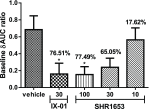Discovery of SHR1653, a Highly Potent and Selective OTR Antagonist with Improved Blood-Brain Barrier Penetration
- PMID: 31223461
- PMCID: PMC6580551
- DOI: 10.1021/acsmedchemlett.9b00186
Discovery of SHR1653, a Highly Potent and Selective OTR Antagonist with Improved Blood-Brain Barrier Penetration
Abstract
The oxytocin receptor (OTR) plays a major role in the control of male sexual responses. Antagonists of the OTR have been reported to inhibit ejaculation in animal models and serve as a potential treatment for premature ejaculation (PE). Herein, we describe a novel scaffold featuring an aryl substituted 3-azabicyclo [3.1.0] hexane structure. The lead compound, SHR1653, was shown to be a highly potent OTR antagonist, which exhibited excellent selectivity over V1AR, V1BR, and V2R. This novel molecule was shown to have a favorable pharmacokinetic profile across species, as well as robust in vivo efficacy in a rat uterine contraction model. Interestingly, SHR1653 exhibited excellent blood-brain barrier penetration, which might be beneficial for the treatment of CNS-related PE.
Conflict of interest statement
The authors declare no competing financial interest.
Figures




Similar articles
-
Cligosiban, A Novel Brain-Penetrant, Selective Oxytocin Receptor Antagonist, Inhibits Ejaculatory Physiology in Rodents.J Sex Med. 2018 Dec;15(12):1698-1706. doi: 10.1016/j.jsxm.2018.10.008. J Sex Med. 2018. PMID: 30527053
-
Potent and selective oxytocin receptor agonists without disulfide bridges.Bioorg Med Chem Lett. 2017 Jun 1;27(11):2331-2335. doi: 10.1016/j.bmcl.2017.04.030. Epub 2017 Apr 12. Bioorg Med Chem Lett. 2017. PMID: 28438540
-
Molecular modeling of interactions of the non-peptide antagonist YM087 with the human vasopressin V1a, V2 receptors and with oxytocin receptors.J Comput Aided Mol Des. 2001 Dec;15(12):1085-104. doi: 10.1023/a:1015905822671. J Comput Aided Mol Des. 2001. PMID: 12160092
-
Design of Oxytocin Analogs.Methods Mol Biol. 2019;2001:235-271. doi: 10.1007/978-1-4939-9504-2_11. Methods Mol Biol. 2019. PMID: 31134574 Review.
-
Identification of neurohypophysial hormone receptor domains involved in ligand binding and G protein coupling.Adv Exp Med Biol. 1998;449:371-85. doi: 10.1007/978-1-4615-4871-3_48. Adv Exp Med Biol. 1998. PMID: 10026828 Review.
References
-
- Gullam J. E.; Chatterjee J.; Thornton S. Preterm labor: novel treatments. Drug Discovery Today: Ther. Strategies 2005, 2, 47–52. 10.1016/j.ddstr.2005.05.023. - DOI
-
- Lamont R. F.; Kam K. Y. R. Atosiban as a tocolytic for the treatment of spontaneous preterm labor. Expert Rev. Obstet. Gynecol. 2008, 3, 163–174. 10.1586/17474108.3.2.163. - DOI
LinkOut - more resources
Full Text Sources
Other Literature Sources
Chemical Information

